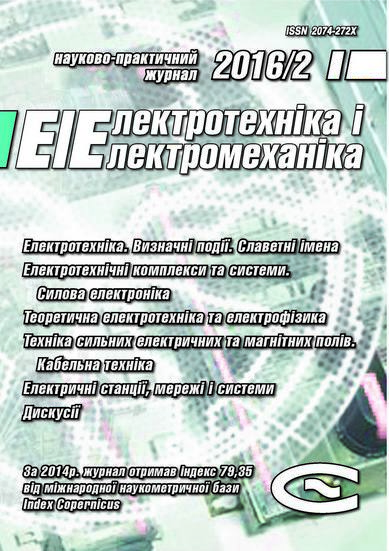A METHOD OF COMPLEX AUTOMATED MONITORING OF UKRAINIAN POWER ENERGY SYSTEM OBJECTS TO INCREASE ITS OPERATION SAFETY
DOI:
https://doi.org/10.20998/2074-272X.2016.2.12Keywords:
power line, electric and magnetic fields, automated monitoring, unmanned aerial vehiclesAbstract
The paper describes an algorithm of the complex automated monitoring of Ukraine’s power energy system, aimed at ensuring safety of its personnel and equipment. This monitoring involves usage of unmanned aerial vehicles (UAVs) for planned and unplanned registration status of power transmission lines (PTL) and high-voltage substations (HVS). It is assumed that unscheduled overflights will be made in emergency situations on power lines. With the help of the UAV, pictures of transmission and HVS will be recorded from the air in the optical and infrared ranges, as well as strength of electric (EF) and magnetic (MF) fields will be measured along the route of flight. Usage specially developed software allows to compare the recorded pictures with pre-UAV etalon patterns corresponding to normal operation of investigated transmission lines and the HVSs. Such reference pattern together with the experimentally obtained maps of HVS’s protective grounding will be summarized in a single document – a passport of HVS and PTL. This passport must also contain the measured and calculated values of strength levels of EF and MF in the places where staff of power facilities stay as well as layout of equipment, the most vulnerable to the effects of electromagnetic interference. If necessary, as part of ongoing monitoring, recommendations will be given on the design and location of electromagnetic screens, reducing the levels of electromagnetic interference as well as on location of lightning rods, reducing probability lightning attachment to the objects. The paper presents analytic expressions, which formed the basis of the developed software for calculation of the EF strength in the vicinity of power lines. This software will be used as a base at UAV navigation along the transmission lines, as well as to detect violations in the transmission lines operation. comparison of distributions of EF strength calculated with the help of the elaborated software with the known literature data has been presented also. The difference between the proposed method of monitoring and the existing methods is full automation of the complex control of a number of parameters characterizing the state of the external power grid facilities, as well as its basic electrical parameters. This will be possible due to usage of specially developed software for recognition of optical and infrared images, as well as pictures of lines of equal EF and MF strength.
References
1. Arbuzov R.S., Ovsyannikov A.G. Sovremennye metody diagnostiki vozdushnykh linii elektroperedachi [Modern methods of diagnostics of overhead power lines]. Novosibirsk, Nauka Publ., 2009. 136 p. (Rus).
2. Skarbek L., Zak A., Ambroziak D. Damage detection strategies in structural health monitoring of overhead power transmission system. 7th European Workshop on Structural Health Monitoring (EWSHM), July 8-11, 2014. La Cité, Nantes, France. pp. 663-670.
3. Li L. The UAV intelligent inspection of transmission lines. Proceedings of the 2015 International Conference on Advances in Mechanical Engineering and Industrial Informatics, 2015. pp. 1542-1545. doi: 10.2991/ameii-15.2015.285.
4. Geraldo J. Adabo. Unmanned aircraft system for high voltage power transmission lines of brazilian electrical system. AUVSI Unmanned Systems, vol.1, pp. 1556-1563, 12-15 August 2013, Washington, DC, USA. ISBN 78-1-62993-324-5.
5. Kachesov V.E., Lebedev D.E. Sposob diagnostiki vyisokovoltnoy linii elektroperedachi [A method for diagnosing a high-voltage power lines]. Patent Russian Federation, no. 2421746, 2011. (Rus).
6. Kachesov V.E., Lebedev D.E. Sposob aerodiagnostiki vyisokovoltnoy linii elektroperedachi [Air diagnostic method of high voltage transmission lines]. Patent Russian Federation, no. 2483314, 2013. (Rus).
7. Shcherba A.A., Rezinkina M.M. Modelirovanie i analiz elektricheskih poley energeticheskih ob'ektov [Modeling and analysis of electric field energy facilities]. Kiev, Naukova Dumka Publ., 2008. 248 p. (Rus).
8. Rezinkina M.M. Technique for predicting the number of lightning strokes to extended objects. Technical physics, 2008, vol.53, no.5, pp. 533-539. doi: 10.1134/s1063784208050010.
9. Bessonov V.A. Elektromagnitnaya sovmestimost [Electromagnetic compatibility]. Khabarovsk, DVGUPS Publishing house, 2000. 80 p. (Rus).
10. Demirchian K.S., Neiman L.R., Korovkin N.V., Chechurin V.L. Teoreticheskie osnovyi elektrotehniki. Tom 3 [Theoretical foundations of electrical engineering. Vol. 3]. Moscoe, Piter Publ., 2006. 377 p. (Rus).
11. Tzinevrakis A.E., Tsanakas D.K., Mimos E.I. Analytical Calculation of the Electric Field Produced by Single-Circuit Power Lines. IEEE Transactions on Power Delivery, vol.23, no.3, pp. 1495-1505. doi: 10.1109/tpwrd.2008.916748.
12. Anamarija Juhas, Miodrag Milutinov, Neda Pekarić-Nađ. Primena Monte Karlo metode za procenu merne nesigurnosti proračuna električnog i magnetskog polja nadzemnih i podzemnih vodova. Available at: http://deet.ftn.uns.ac.rs/files/tehres/TR_2012_Juhas_Milutinov_Pekaric.pdf (Accessed 12 September 2013). (Srb).
Downloads
Published
How to Cite
Issue
Section
License
Copyright (c) 2016 Ye. I. Sokol, M. M. Rezinkina, O. G. Gryb, V. I. Vasilchenko, A. A. Zuev, A. V. Bortnikov, E. V. Sosina

This work is licensed under a Creative Commons Attribution-NonCommercial 4.0 International License.
Authors who publish with this journal agree to the following terms:
1. Authors retain copyright and grant the journal right of first publication with the work simultaneously licensed under a Creative Commons Attribution License that allows others to share the work with an acknowledgement of the work's authorship and initial publication in this journal.
2. Authors are able to enter into separate, additional contractual arrangements for the non-exclusive distribution of the journal's published version of the work (e.g., post it to an institutional repository or publish it in a book), with an acknowledgement of its initial publication in this journal.
3. Authors are permitted and encouraged to post their work online (e.g., in institutional repositories or on their website) prior to and during the submission process, as it can lead to productive exchanges, as well as earlier and greater citation of published work.





